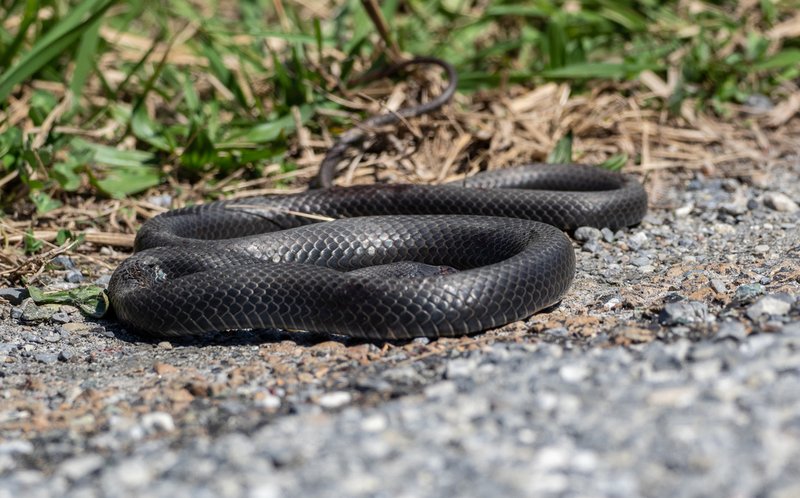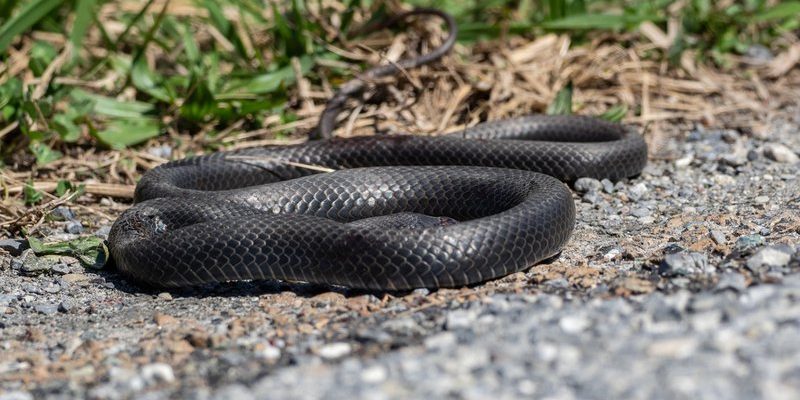
Picture yourself in a lush, green landscape, the sun shining down, and the gentle rustle of leaves in the breeze. Suddenly, a sleek and fast-moving creature darts past you, leaving a blur of black in its wake. This swift shadow is the Black Racer, a snake that captivates many with its speed and sleek looks. Whether you’re walking through a park or exploring the countryside, encountering a Black Racer can be an exciting event that leaves you curious about this amazing reptile.
The Black Racer, known scientifically as Coluber constrictor, is a non-venomous snake found predominantly in North America. Its remarkable adaptability to various environments makes it a common sight in both urban and rural areas. But there’s more to this snake than just its speed and striking appearance. In this article, we’ll explore the Black Racer’s habitat, diet, behavior, and much more, uncovering what makes this creature so intriguing.
Physical Characteristics
The first thing you’ll notice about a Black Racer is its stunning appearance. These snakes have a sleek, shiny body that is predominantly a glossy black, with a subtle bluish hue in certain light. The adults can grow anywhere from 2 to 6 feet in length, depending on their habitat and availability of food. They sport a slender build, which aids in their remarkable speed. Imagine a sprinter on a track—this snake is built for the race!
Juveniles have a different look, sporting a more patterned appearance. They are typically grayish with lighter spots, which helps them blend into their surroundings as they learn to navigate their environment. Over time, as they mature and shed their skin, they lose this juvenile coloration and transition into the adult black sheen that is so characteristic of the species.
Black Racers also feature distinctive large, round eyes that are an advantage for spotting predators and prey. Their keen eyesight allows them to hunt effectively, especially during the day when they are most active. To top it all off, their streamlined bodies and powerful muscles enable them to move swiftly, making them one of the fastest snakes in North America.
Habitat and Range
Black Racers can be found widespread across the eastern United States, stretching from southern Maine all the way down to Florida, and even out to the Midwest. This adaptability allows them to thrive in diverse environments, from forests and grasslands to suburban backyards. They have a knack for making any space feel like home.
These snakes prefer open areas where they can bask in the sunlight—after all, they’re cold-blooded and need warmth to regulate their body temperature. You might find them lounging on rocks, fallen logs, or even pathways. Despite their love for open spaces, they are also keen on hiding in dense vegetation or beneath leaf litter to ambush their prey or avoid being spotted by potential threats.
Interestingly, Black Racers are often seen in areas that have been disturbed or developed. They adapt remarkably well to human environments, often foraging for food in gardens or parks. It’s almost as if they’ve taken a cue from humans, learning to coexist and thrive alongside us in our most familiar spaces.
Diet and Hunting Behavior
When it comes to food, the Black Racer is quite the opportunistic feeder. Its diet mainly consists of small rodents, lizards, and amphibians. They are also known to munch on insects and even the occasional bird. With their speed and agility, these snakes are skilled hunters, using their keen eyesight to spot potential meals from a distance.
What’s truly fascinating is how they hunt. Black Racers typically employ a strategy of stealthy approach followed by a rapid strike. They often rely on their speed to catch prey off guard, darting in for the kill. It’s like watching a well-rehearsed ballet, where every movement is calculated and executed with precision.
Once they’ve captured their meal, they swallow it whole, thanks to their flexible jaws. Unlike some snakes that constrict their prey, Black Racers don’t need to. Their speed and surprise are their primary tools. After a satisfying meal, they may bask in the sun to aid digestion, showcasing their adaptability to diverse eating habits.
Behavior and Social Structure
Black Racers are primarily diurnal, meaning they are most active during the day. You might notice them basking on warm surfaces in the morning or early afternoon. They are also known for their alert and fast-paced nature. If they feel threatened, they won’t hesitate to flee at remarkable speeds, which can reach up to 4 miles per hour. They are more likely to escape than to confront danger, letting their speed do the talking.
Interestingly, during breeding season, which typically occurs in the spring, Black Racers become a bit more social. Males will engage in wrestling to establish dominance and attract females. It’s a fascinating spectacle that resembles a dance-off, showcasing their agility and strength.
While they may not form long-term bonds, females lay clutches of about 5 to 20 eggs in safe spots, such as rotting logs or compost piles. After laying their eggs in June or July, the care for the young is non-existent, as the hatchlings are left to fend for themselves. This independence can be seen as a rite of passage, ensuring that only the fittest survive.
Conservation Status
In terms of conservation, the Black Racer is currently listed as a species of least concern. Their resilience and adaptability have helped them thrive, even as their habitats change. However, some localized populations may face threats from habitat destruction and road mortality. It’s vital for us to recognize their role in the ecosystem as both predators and prey.
Conservation efforts that focus on habitat preservation can help ensure that Black Racers continue to thrive in their natural environments. By creating wildlife corridors and protecting open spaces, we can support these swift snakes and the biodiversity they represent. It’s all about finding that balance between human development and wildlife preservation.
If you encounter a Black Racer in the wild, remember that they are generally harmless and a key part of the ecosystem. Observing them from a distance allows you to appreciate their beauty and role in nature without causing them stress or harm.
Interesting Facts About the Black Racer
| Common Name: | Black Racer |
| Scientific Name: | Coluber constrictor |
| Size: | 2 to 6 feet |
| Speed: | Up to 4 miles per hour |
| Diet: | Rodents, lizards, amphibians, insects |
| Lifespan: | Up to 10 years in the wild |
| Habitat: | Forests, grasslands, urban areas |
| Behavior: | Diurnal, agile, opportunistic hunter |
FAQ
What do Black Racers look like?
Black Racers are recognizable by their smooth, glossy black bodies, often appearing with a bluish tint in certain lights. They are slender, growing anywhere from 2 to 6 feet long. Young Black Racers have a more patterned appearance with gray hues and lighter spots, which they lose as they mature into their adult coloration.
Are Black Racers dangerous to humans?
No, Black Racers are non-venomous and generally harmless to humans. While they might hiss or strike if threatened, they prefer to escape rather than confront. Their role in controlling rodent populations makes them beneficial to have in the ecosystem.
How fast can Black Racers move?
Black Racers are impressive sprinters, capable of reaching speeds up to 4 miles per hour. Their streamlined bodies and strong muscles allow them to dart away quickly when they sense danger, making them one of the fastest snakes in North America.
Where can I find Black Racers?
You can spot Black Racers in a variety of habitats, including forests, grasslands, and even suburban areas. They thrive in open spaces and are often seen basking on rocks or pathways during the day. If you find yourself in these environments, keep an eye out for their distinctive black forms.
What do Black Racers eat?
The diet of Black Racers consists mainly of small mammals, lizards, and amphibians, along with some insects and birds. They are opportunistic hunters, using their speed and agility to catch prey. After a meal, they bask in the sun to aid in digestion.
How do Black Racers breed?
During the spring breeding season, male Black Racers engage in wrestling matches to compete for female attention. After mating, females lay clutches of 5 to 20 eggs in safe locations like rotting logs or compost piles, leaving the young to fend for themselves once they hatch.
What threats do Black Racers face?
While Black Racers are currently listed as a species of least concern, they do face threats like habitat destruction and road mortality. Protecting their habitats and raising awareness about their importance in the ecosystem is crucial for their survival.
Are Black Racers good pets?
While some people keep snakes as pets, Black Racers are wild creatures that thrive in their natural habitats. They are fast, active snakes that require specific care and environments to stay healthy. It’s best to appreciate them in the wild rather than trying to keep them as pets.
How long do Black Racers live?
In the wild, Black Racers can live for up to 10 years. Their lifespan can be affected by various factors such as predation, food availability, and environmental conditions. Observing them in their natural habitats allows you to admire their beauty while respecting their life cycle.

